Heap Operations
Insertion
To insert an item into the heap, we will need to maintain the heap property. To do this we will start by inserting the item into the next available array location, and then fix the heap. Fixing the heap after an insertion is called upheaping.
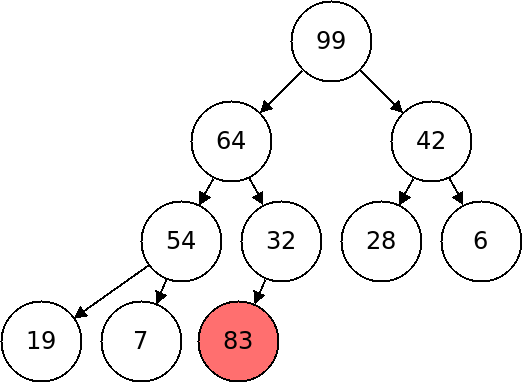
The above heap has an element (in red) inserted in the next available location. To fix the heap, we will test if the item we inserted is less than its parent. If not we will swap the node with its parent.

In the above heap, we swapped 83 with its parent 32. We will repeat this process until the parent is greater, or the node we inserted becomes the root.
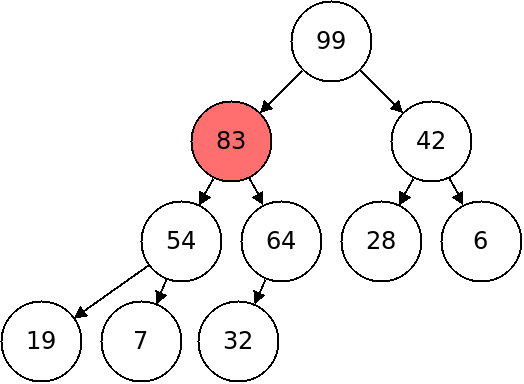
This heap shows the final result of inserting 83.
The algorithm for insertion is given below:
- Insert the item at the next available location.
- While the item is not the root, and it has a greater value than its parent:
- Swap the item with its parent.
Below is a method for insertion for a class which stores integers in a heap:
// insert an item into the heap
public void insert(int item) {
// put the new one in the next slot
array[count] = item;
int node = count;
int p = parent(node);
count++;
// upheap it until it is under a node which is bigger than it (or the root)
while ((node != 0) && (array[node] > array[p])) {
int temp = array[node];
array[node] = array[p];
array[p] = temp;
node = p;
p = parent(node);
}
}
What is the Big-O of the insertion algorithm?
Well, actually putting the data into the next available slot takes a constant amount of time. The only part that loops is the upheaping loop. So how many times could we have to upheap? The worst case scenario is that we need to upheap all the way to the top. Luckily we know that the tree is perfectly balanced. In a balanced tree with $N$ nodes, there are no more than $log_2(N)$ levels. So the insertion is $O(\log N)$.
Removing the Top
When we want to find the max element, it will be stored in the top of the heap. Typically, when we look at the top of the heap, we will also want to remove that item. In the heap below, for example, we would want to remove the root element, 99.
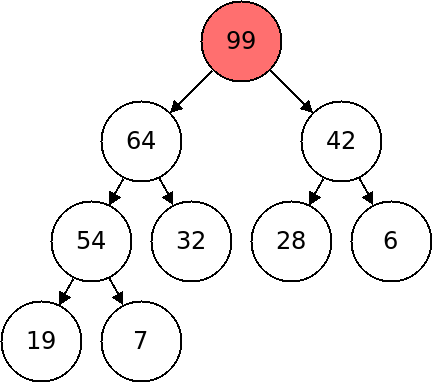
After deletion, we need to maintain the property that the heap is fully left aligned. This means that the spot we need to remove is the rightmost one in the bottom level.
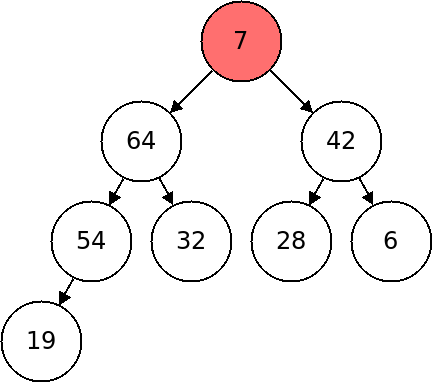
So to delete the root, we will swap it with the last element in the bottom level (as illustrated above). Then we will remove the last element in the bottom. Finally we will fix the heap by downheaping.
To downheap, we will check if the item is bigger than both children, if not we will swap it with its larger child and repeat. This is illustrated below:
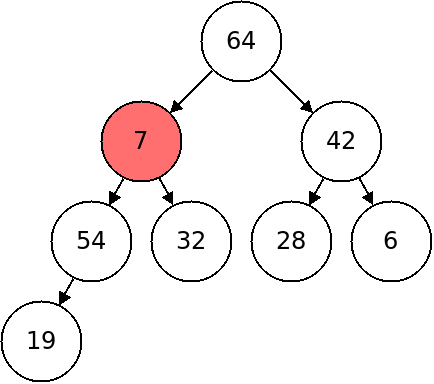
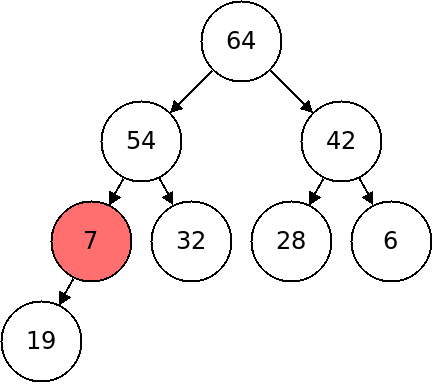

In pseudocode:
- Save the root as the return value.
- Move the last child to the root.
- While one of the children of this node has a greater value:
- Find the largest of the children.
- Swap the largest child with this node.
- Return the original value.
In Java:
// remove the top item
public int dequeue() {
// save the item to return it
int value = array[0];
// move the last item to the root and decrement
array[0] = array[count - 1];
count--;
// find the children
int node = 0;
int l = left(node);
int r = right(node);
// while one of the children is bigger - or equal
while (((l < count) && (array[l] > array[node])) ||
((r < count) && (array[r] > array[node]))) {
// find the larger node
int max;
// if there are two, take larger
if ((l < count) && (r < count)) {
if (array[l] > array[r])
max = l;
else
max = r;
}
// if just one take that one
else if (l < count) {
max = l;
} else {
max = r;
}
// swap them
int temp = array[max];
array[max] = array[node];
array[node] = temp;
node = max;
l = left(node);
r = right(node);
}
return value;
}
Like insertion, this algorithm only has one loop in it, which loops for as many times as we need to downheap. For the same reasons, that makes it $O(\log N)$.
A full example of a heap storing integers can be seen in HeapExample.java.